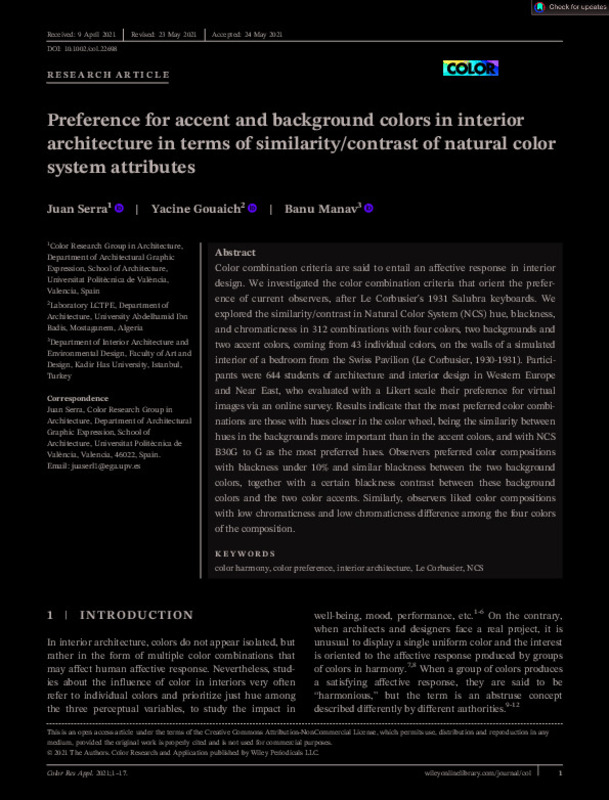JavaScript is disabled for your browser. Some features of this site may not work without it.
Buscar en RiuNet
Listar
Mi cuenta
Estadísticas
Ayuda RiuNet
Admin. UPV
Preference for accent and background colors in interior architecture in terms of similarity/contrast of natural color system attributes
Mostrar el registro sencillo del ítem
Ficheros en el ítem
| dc.contributor.author | Serra, Juan
|
es_ES |
| dc.contributor.author | Gouiach, Yacine
|
es_ES |
| dc.contributor.author | Manav, Banu
|
es_ES |
| dc.date.accessioned | 2022-11-24T19:03:12Z | |
| dc.date.available | 2022-11-24T19:03:12Z | |
| dc.date.issued | 2022-02 | es_ES |
| dc.identifier.issn | 0361-2317 | es_ES |
| dc.identifier.uri | http://hdl.handle.net/10251/190160 | |
| dc.description.abstract | [EN] Color combination criteria are said to entail an affective response in interior design. We investigated the color combination criteria that orient the preference of current observers, after Le Corbusier's 1931 Salubra keyboards. We explored the similarity/contrast in Natural Color System (NCS) hue, blackness, and chromaticness in 312 combinations with four colors, two backgrounds and two accent colors, coming from 43 individual colors, on the walls of a simulated interior of a bedroom from the Swiss Pavilion (Le Corbusier, 1930-1931). Participants were 644 students of architecture and interior design in Western Europe and Near East, who evaluated with a Likert scale their preference for virtual images via an online survey. Results indicate that the most preferred color combinations are those with hues closer in the color wheel, being the similarity between hues in the backgrounds more important than in the accent colors, and with NCS B30G to G as the most preferred hues. Observers preferred color compositions with blackness under 10% and similar blackness between the two background colors, together with a certain blackness contrast between these background colors and the two color accents. Similarly, observers liked color compositions with low chromaticness and low chromaticness difference among the four colors of the composition. | es_ES |
| dc.language | Inglés | es_ES |
| dc.publisher | John Wiley & Sons | es_ES |
| dc.relation.ispartof | Color Research & Application | es_ES |
| dc.rights | Reconocimiento - No comercial (by-nc) | es_ES |
| dc.subject | Color harmony | es_ES |
| dc.subject | Color preference | es_ES |
| dc.subject | Interior architecture | es_ES |
| dc.subject | Le Corbusier | es_ES |
| dc.subject | NCS | es_ES |
| dc.subject.classification | EXPRESION GRAFICA ARQUITECTONICA | es_ES |
| dc.title | Preference for accent and background colors in interior architecture in terms of similarity/contrast of natural color system attributes | es_ES |
| dc.type | Artículo | es_ES |
| dc.identifier.doi | 10.1002/col.22698 | es_ES |
| dc.rights.accessRights | Abierto | es_ES |
| dc.contributor.affiliation | Universitat Politècnica de València. Escuela Técnica Superior de Arquitectura - Escola Tècnica Superior d'Arquitectura | es_ES |
| dc.description.bibliographicCitation | Serra, J.; Gouiach, Y.; Manav, B. (2022). Preference for accent and background colors in interior architecture in terms of similarity/contrast of natural color system attributes. Color Research & Application. 47(1):135-151. https://doi.org/10.1002/col.22698 | es_ES |
| dc.description.accrualMethod | S | es_ES |
| dc.relation.publisherversion | https://doi.org/10.1002/col.22698 | es_ES |
| dc.description.upvformatpinicio | 135 | es_ES |
| dc.description.upvformatpfin | 151 | es_ES |
| dc.type.version | info:eu-repo/semantics/publishedVersion | es_ES |
| dc.description.volume | 47 | es_ES |
| dc.description.issue | 1 | es_ES |
| dc.relation.pasarela | S\438940 | es_ES |
| dc.subject.ods | 03.- Garantizar una vida saludable y promover el bienestar para todos y todas en todas las edades | es_ES |
| dc.subject.ods | 11.- Conseguir que las ciudades y los asentamientos humanos sean inclusivos, seguros, resilientes y sostenibles | es_ES |








